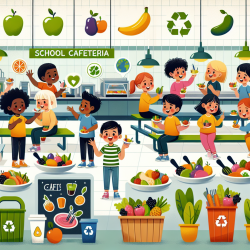Introduction
The Cafeteria Assessment for Elementary Schools (CAFES) is an innovative tool designed to assess and enhance the physical attributes of school cafeterias to promote healthier eating habits among elementary students. This tool is particularly relevant for speech-language pathologists and other practitioners focused on child development, as it provides a data-driven approach to improving nutrition, which is crucial for cognitive and communicative development.
Understanding CAFES
CAFES evaluates four environmental scales within school cafeterias: room, table/display, plate, and food. Each scale is meticulously assessed through 198 items grouped into 108 questions. The tool’s reliability and predictive validity have been tested across multiple schools, showing a significant association between the cafeteria environment and the consumption of fruits and vegetables (FV).
Implementing CAFES in Practice
For practitioners aiming to improve child nutrition, implementing CAFES can be a game-changer. Here are some actionable steps:
- Conduct a CAFES Assessment: Use the CAFES tool to conduct a thorough assessment of the school cafeteria environment. Identify areas that need improvement, such as lighting, food presentation, and layout.
- Prioritize Interventions: Based on CAFES scores, prioritize interventions that are low-cost and easy to implement. For example, rearranging food items to make healthy choices more accessible or improving signage to promote healthy eating.
- Collaborate with School Staff: Work with school administrators and cafeteria staff to implement changes. Provide training on the importance of cafeteria design and its impact on student nutrition.
- Monitor and Evaluate: After implementing changes, use CAFES to monitor improvements in FV consumption. This data-driven approach will help in evaluating the effectiveness of interventions.
Encouraging Further Research
While CAFES provides a robust framework for assessing and improving school cafeterias, further research is encouraged to explore additional environmental factors and their impact on child nutrition. Practitioners can contribute to this field by conducting studies that examine the long-term effects of cafeteria interventions on child health outcomes.
Conclusion
CAFES offers a practical and evidence-based approach to enhancing the school food environment, ultimately promoting healthier eating habits among children. By leveraging this tool, practitioners can make significant strides in improving child nutrition and supporting cognitive and communicative development.
To read the original research paper, please follow this link: Cafeteria assessment for elementary schools (CAFES): development, reliability testing, and predictive validity analysis.










